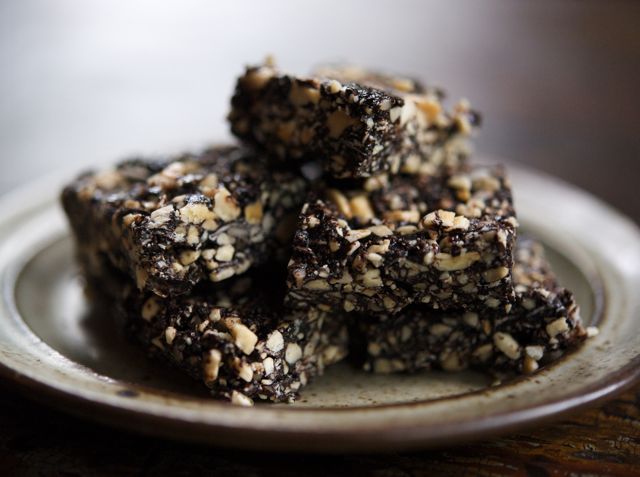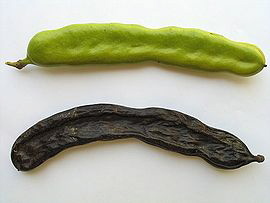6.15.10 Chew On This
Growing up in Santa Cruz, still a hippie mecca to this day, I was exposed early on to all manner of what used to be known as "health foods"—sprouts, carob, smoothies, kefir, whole grain sourdough bread. Maybe that's why I still enjoy trawling about crunchy food co-ops, peering at bags of sesame sticks, bins of millet and containers of powdered spirulina. There is almost always an assortment of carob-covered items (raisins, almonds, ginger) and sometimes these little nuggets, studded with lots of goodies. I love carob's dark, earthy richness; its mild bitterness and distinct winey taste hold up to chocolate's complexity. Carob is a species of flowering evergreen tree in the pea family that is cultivated for its edible seed pods, which are also known as "St. John's bread" because John the Baptist was said to have subsisted on them in the wilderness. Supposedly they also fed Mohammed's armies. The pod can be elongated, compressed, straight or curved and takes a full year to develop and ripen. It is the dried and sometimes roasted pod that we eat, and not the peas or seeds inside. These are called locust beans and are used for animal feed or as the source of locust bean gum, a thickening agent that is an ingredient in many processed foods.
An incredibly rich food source, carob is perhaps the ideal "survival food" since it lasts a long time, requires no special storage conditions, and can be eaten with no preparations. It has twice the calcium of milk and contains no oxalic acid, as does chocolate, which tends to interfere with the body's ability to absorb calcium. It's about 4% protein and 76% carbohydrates and, although very sweet, has 60% fewer calories than chocolate. Additionally, carob contains substantial phosphorus, an abundance of potassium, vitamin A and B vitamins, and small amounts of sodium and iron. I'm actually not sure why we don't hear more about carob as a superfood, and as a delicious, versatile ingredient.
These chewy little snacks are great to have around when you need an energy boost or your sweet tooth is acting up. They are satisfying and nutritious. You can whip them up in no time flat using whatever nuts you like and keep a container of them in your fridge or a cool cupboard.
Carob Chews
makes about 2 dozen small squares
adapted from Nourishing Traditions
adapted from Nourishing Traditions
- — 2 cups lightly roasted almonds, cashews and walnuts (or any combination of nuts and/or seeds you like)
- — 1/2 cup carob powder, preferably organic
- — 1/2 cup raw wildflower honey
- — 1 tablespoon vanilla extract
- — 1 teaspoon sea salt
- — 1/2 teaspoon ground cardamom
- — 1/3 cup raw sunflower seeds
- — 1 cup dried unsweetened coconut
Place honey, carob, vanilla and salt in a double boiler over medium-low heat (or a bowl set in a pan of simmering water) and stir until melted. Blend well.
Meanwhile, place nuts in food processor and pulse until finely chopped but not pulverized. Add honey-carob mixture, coconut and sunflower seeds to nuts and pulse a few more times to incorporate.
Line a 9x12 pan with buttered parchment paper and spread mixture about 1/2-3/4" thick. Cover with more parchment and refrigerate several hours until quite firm. Cut into small squares and store in an airtight container in the fridge or in a cool cupboard.
 Download Recipe
Download Recipe








9 Comments